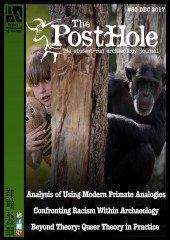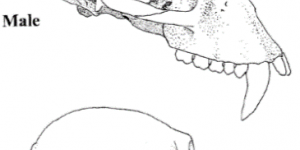On the 17th of May, Tabitha Kabora chaired a seminar on the issue of racism within archaeology. This is a short article based on the points discussed during that session, written by the editor with the permission and cooperation of Tabitha.
It ought to be acknowledged, first and foremost, that the issue of racism is a complex one, encompassing much more than those overtly racist acts which the majority of people find reprehensible, and which are denounced accordingly. Racial discrimination can be based on internalised prejudices, which are both harder to identify in others, and more difficult to accept and confront in ourselves. Implicit and institutional discrimination are insidious, and require meaningful dialogue and critical reflection if they are to be tackled effectively. That is not to say that the required arguments cannot be made, nor that the issues should be tiptoed around, but rather that the highly sensitive nature of the topic can deter people from engaging with it, especially if the discussion is not navigated with a certain degree of thought and subtlety.
Racism, in its simplest form, is an ideology which gives expression to myths regarding other racial and ethnic groups, devaluing those groups and resulting in negative perceptions and imposed racial hierarchies. It reflects, and is perpetuated by, deeply rooted historical, social and cultural inequalities, and therefore is linked very much to ideas of power. In postcolonial theory, for example, the term ‘subaltern’ is used to define those populations which were socially, politically and geographically outside of the hegemonic power structure imposed by the colonial authority. Colonialism was a very direct and often very violent imposition of foreign control, its discrimination and exploitation of native populations driven by the West’s misplaced belief in a moral obligation to gentrify the ‘ruder’ nations (see Kipling’s poem ‘The White Man’s Burden’, published in 1899). However, racism does not presuppose violence, nor does it necessarily emerge from a feeling of superiority. Xenophobia, the fear or mistrust of that which is foreign, can be a result of insecurities regarding one’s personal and national identity and, if prevalent at a governmental level, can inform policy decisions concerning immigration. Xenophobia can thus engender a lack of diversity, which in turn reinforces, or rather fails to correct, those stereotypes held of the ‘other’. To complicate the issue even further, implicit racial bias refers to unconscious prejudices which belie sincere claims to non-discriminatory behaviour. In such cases, individuals may adopt defensive positions, from which discussions of racism can be perceived as accusatory rather than discursive.
With regards to racism within archaeology, it is worth making the distinction between representation and archaeological practice, although the two are undeniably intertwined. In terms of the former, it is of enormous concern that only 1% of professional archaeologists working in 2012/13 were of BME (Black and Minority Ethnic) heritage. This statistic is even more alarming when one also considers the limited number of BME students pursuing archaeology as a first degree, as well as the strikingly few BME individuals volunteering in the field. Can this lack of diversity be attributed purely to racist attitudes, either through explicit discrimination or implicit racial bias? It would not be controversial to suggest that there are, in fact, wider societal issues at play. Although sweeping generalisations are unhelpful (and potentially counter-productive), it may be useful to acknowledge the socioeconomic issues that many BME families face, and the role this plays when it comes to higher education. For example, a BME student raised in a poor urban area is likely to have worked harder than others to earn a place at university. Having fought that fight, it is perhaps unsurprising that archaeology, which rarely leads to highly paid employment (and often requires working outdoors in less than perfect conditions), loses out to higher paying, career-driven courses such as medicine or law. The choices of BME students need to be taken into account.
In terms of archaeological practice, there are a number of elements which serve to discourage minority students from engaging with the discipline. Firstly, there is a tendency, certainly at a university level, to teach Roman, Viking, and Anglo-Saxon archaeology at the expense of non Western histories. This can be attributed, in part, to the European origins of the subject, and yet it also betrays archaeology’s inherent Eurocentrism, which developed out of a belief that Europeans were evolutionary frontrunners, socially and intellectually predisposed to conquer, educate and gentrify. This subjugated non-Western epistemologies and has implicitly entrusted Europe with the role of arbiter when it comes to historical ‘truth’. Moreover, Eurocentrism provided colonialists with justification for their presence in foreign countries, their claims to legitimacy bolstered by judiciously chosen archaeological projects. The French in Algeria, for example, excavated and politicised Roman remains, professing themselves the heirs of imperial Rome. Local heritage was either ignored or, as in the case of early studies of Great Zimbabwe, interpreted in such a way as to conform with racist notions of native incompetence. Fortunately, postcolonial theory has improved the situation to a degree. The entanglement of cultures and identities and academic disciplines within archaeology is now subject to critical interrogation. History is no longer thought of as a progressive expansion of the West, nor is the rest of the world as romanticised as it once was (on this last point, see Edward Said’s ‘Orientalism’, published in 1978). Archaeology is beginning to understand its imperialist heritage, although work still needs to be done to transcend its European biases.
In the first instance, educating archaeologists and engaging minority groups are important steps which need to be taken to diversify archaeological discourse. Western universities need to set their sights beyond Europe, exploring African, South American and Asian archaeologies, and examining them above and beyond their relations with Europe. History does not begin at the point of contact between Europe and other cultures, and archaeological research and education should reflect this. Research should not only incorporate native epistemologies as a means of countering Eurocentrism, but publications should be accessible to those indigenous communities. It is their history, and should be allowed to inform their narratives. Of course, the idea that European academics are the best qualified to record indigenous histories is absurd, as is the notion that such histories are neglected in the absence of Western intervention. On an administrative level, funding and resources should be diversified to better represent the interests of minority groups, which would encourage enthusiasts from those groups to study and volunteer in greater numbers. Racism should also be discussed openly, to remove the burden of that discussion from the shoulders of BME students and academics. If all of these suggestions were embraced by Western archaeologists, the discipline would attract not only a multiplicity of people, but a multiplicity of ideas, improving our understanding of diverse cultures in both the past and the present.
Thanks again to Tabitha Kabora for chairing her seminar on racism within archaeology, and for her invaluable assistance when it came to writing this article.
Bibliography
- Aitchison, K and Rocks-Macqueen, D. 2013. Archaeology Labour Market Intelligence: Profiling the Profession 2012–13. Sheffield: Landward Research.
- Equality Challenge Unit 2015. Academic flight: how to encourage black and minority ethnic academics to stay in UK higher education. Research report. ECU
- Gutiérrez-Rodríguez, E. 2016. Sensing dispossession: Women and gender studies between institutional racism and migration control policies in the neoliberal university. Women's Studies International Forum, 54, 167-177.
- Hamilton, S. 2014. Under-Representation in Contemporary Archaeology. Papers from the Institute of Archaeology. 24(1), p.Art. 24. DOI: http://doi.org/10.5334/pia.469
- Harper, S. R. 2012 Race without Racism: How Higher Education Researchers Minimize Racist Institutional Norms. The Review of Higher Education, vol. 36 no. 1, 2012, pp. 9-29. The Johns Hopkins University Press . doi:10.1353/rhe.2012.0047
- Higher Education Statistics Agency
- Holroyd, J. 2015. Implicit racial bias and the anatomy of institutional racism. Criminal Justice Matters, 101, 30-32.
- Tomalin, E. 2007. Supporting cultural and religious diversity in higher education: pedagogy and beyond. Teaching in Higher Education, 12, 621-634.
- Universities UK 2016. Higher Education in Facts and Figures. 2016.
http://www.universitiesuk.ac.uk/facts-and-stats/Pages/data-analysis-repo...





